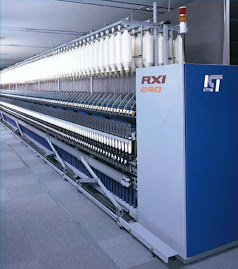
Slub yarns
- Slub yarn is charactorised by having, alternating short places of thin, firm twist yarn, with places of very thick, loose twist yarn
- The differnt areas can be at regular or irregular intervals
Knop or button yarns
- These yarns are also made by feeding the yarns at different rates while spinning
- But this time the excess yarn of one or more of the components forms bunches
- These can be at regular or irregular intervals
Snarl yarns
- Snarl yarns are made in a similar way to loop yarns
- Except the effect yarn has a high, lively twist, so that the excess bits snarl and double up on themselves and twist together
- (Just like the lengths of cord we make on a door-knob!)
Boucle, gimp and loop yarns
- These yarns are made by feeding one or more effect yarns faster than the core yarn while spinnin
- boucle has a hard twisted core yarn, the effect yarn is rapidly twisted round the core so that excess yarn forms an irregular wavy, bumpy surface
- gimp is much the same as boucle, but the excess yarn forms a more regular surface
- loop yarn is the result of the excess soft spun yarn being formed into well shaped circular

Marl yarns
- Marl yarns are made by twistng together two or more ends of different coloured yarns
- The effect pattern is one of regular diagonal stripes of each colour
Spiral and corkscrew yarns
- These are plied yarns where one yarn wraps around the other, rather than the yarns being twisted together
- A spiral yarn has a higher twist than a corkscrew yarn
- A spiral yarn usually has a thinner yarn wrapped round a thicker core
- A corkscrew yarn has a softer bulkyer yarn wrapped round a thin, firm yarn
Chenille yarns
- chenille yarns have a soft, fuzzy cut pile which is bound to a core
- These yarns can be spun, but the machinery required is very specialised For this reason, these yarns are usually woven on a loom
- The effect yarn forms the warp, which is bound by a weft thread
- The weft thread is spaced out at a distance of twice the required length of pile
- The warp is then cut half way between each weft thread.
Ribbon yarns
- These yarns are not produced by spinning
- They are finely knitted tubes, pressed flat to resemble ribbon or tape
- The ribbons are usually soft, shiny and silky



This comment has been removed by the author.
ReplyDeleteThanks for sharing among us.
ReplyDeleteFor further information go through... What is fancy yarn